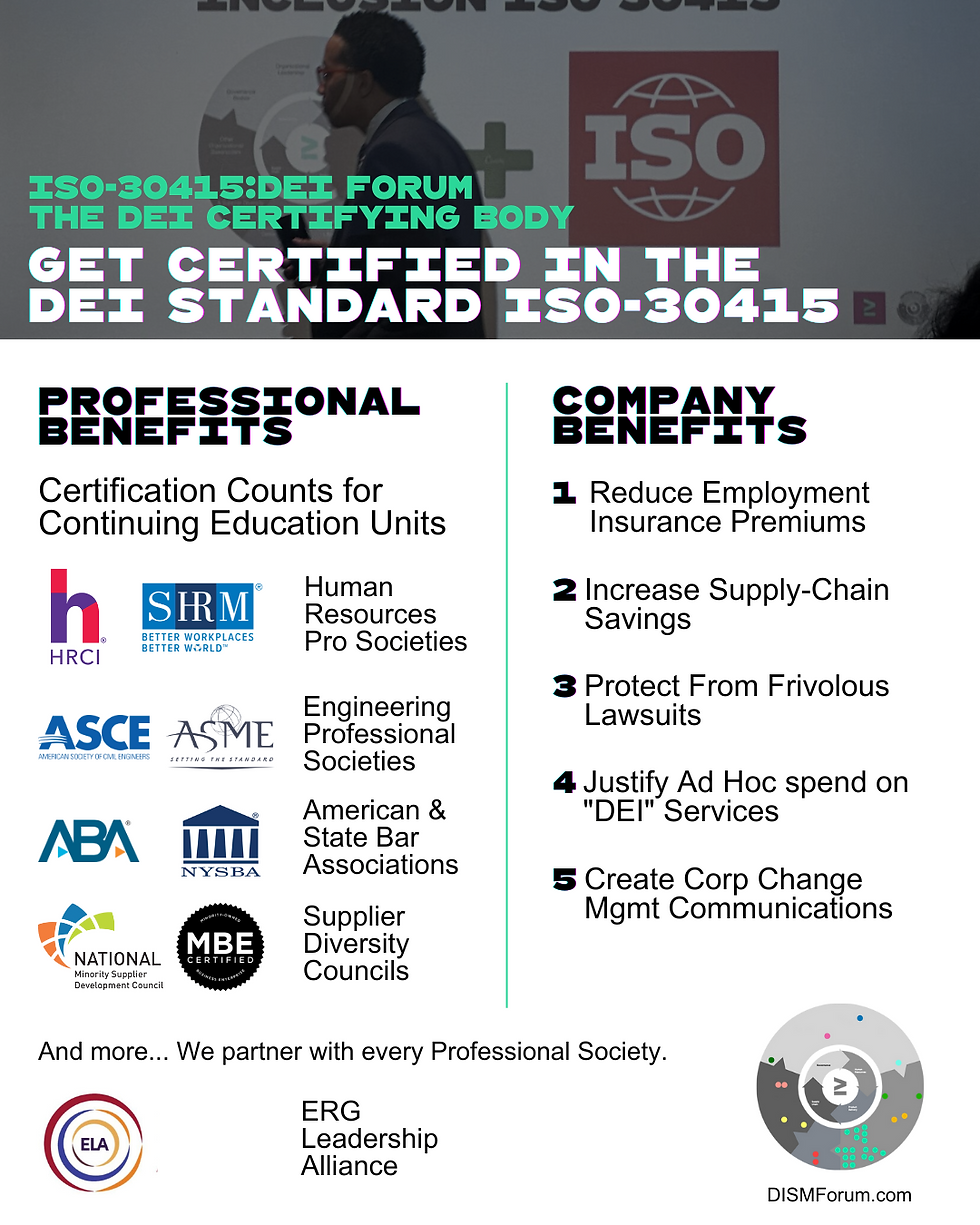California's A.I. Employment Regs
- Kharena Coleman

- Aug 4
- 3 min read
California’s proposed regulations on Automated Decision Systems (ADS)—approved by the California Civil Rights Council in March 2025—set a new standard for ensuring fairness, transparency, and accountability in workplace AI. As organizations prepare for compliance, integrating ISO‑30415’s structured DEI framework can transform legal obligations into robust governance, risk management, and resilience.

⚖️ Purpose: Aligning Legal Compliance with Inclusive Strategy
ISO‑30415 Requirement: Governance bodies must define DEI principles, objectives, and accountabilities—embedding them into all organizational policies, including those governing HR and technology deployments Inclusion ScoreIteh Standards.
California Regulation Requirement: ADS may not discriminate on protected characteristics, must be bias-tested, and employers are liable—even if third-party tools cause harm California Employment Law Report.
Integrated Approach: Use ISO‑30415 governance protocols to document ADS risk assessments, define leadership roles responsible for compliance, and ensure transparency throughout planning, deployment, and review cycles.
1. Human Resources Life‑Cycle & Automated Tools
ISO‑30415 Action: Embed inclusive recruitment, performance, and mobility practices, backed by quantitative and qualitative data, in HR policies.
California Regulation: Employers must provide notice to applicants when ADS tools are used, offer accommodations for candidates with protected characteristics or disabilities, and ensure human oversight in decision-making.
Integrated Approach: Formalize ADS usage in your HR lifecycle under ISO’s “Recruitment” and “Learning & Development” service types. Align candidate communication materials and accommodation procedures to both ISO and regulatory mandates. Embed anti‑bias training for recruiters and hiring managers aligned to ISO‑30415 competence expectations.
2. Anti‑Bias Testing & Data Governance
ISO‑30415 Requirement: Inclusive systems and processes must include checks, balances, and reliable demographic results to monitor fairness—especially in emerging technologies and automated decision systems Iteh StandardsTÜV SÜD.
California Regulation: Employers are required to conduct, document, and retain bias testing for at least four years, store this separately, and correct any discriminatory impact California Employment Law Report.
Integrated Approach: Use ISO‑30415 measurement and monitoring frameworks to integrate bias-testing as part of DEI objectives. Capture quantitative demographic analyses and mitigation steps as part of continuous improvement cycles. This approach ensures both legal traceability and maturity in inclusion outcomes.
3. Vendor and Supplier Management
ISO‑30415 Theme: Supplier diversity and inclusive external stakeholder management must emphasize transparent criteria, accessibility, and readiness—not preferential selection based on protected traits TÜV SÜD Inclusion Score.
California Rule: Employers remain liable for ADS implemented by third‑party vendors and should include indemnification terms and compliance expectations in contracts California Employment Law Report.
Integrated Approach: Adopt ISO-aligned procurement practices—evaluate vendors using inclusive and merit-based criteria, require bias test documentation, and assign supplier DEI accountability. Formalize vendor contracts to reflect these responsibilities.
4. Organizational Accountability & Records Management
ISO‑30415 Governance: Roles and responsibilities tied to DEI must be documented and outcomes reviewed; inform internal stakeholders through transparency, feedback, and inclusive communications.
California Regulation: ADS records, demographic data, bias test results, and decision rationale must be stored separately (not in personnel files) for four years, and history must be human-monitored.
Integrated Approach: Create a document governance process that stores ADS records under ISO’s monitoring and review protocols. Link these datasets with DEI maturity indicators and integrate review outcomes into annual DEI reporting.
✅ Action Checklist: Align DEI and AI Compliance
California Regulatory Requirement | ISO‑30415 Integration |
Bias testing and remediation for ADS | Include bias checks in ISO measurement cycle & continuous improvement |
Disclosure and candidate notice procedures | Incorporate into ISO communications and HR lifecycle policies |
Accommodations for protected individuals | Align to ISO prerequisites for equitable participation & access |
Human oversight of decisions | Define roles through ISO governance structures and human review process |
Vendor compliance responsibility | Apply ISO supplier diversity frameworks to contractual management |
Four-year record retention and separation | Integrate into ISO documentation control and data governance systems |
🧩 Why This Approach Works
ISO‑30415 offers structure for governance, accountability, and continuous improvement across HR, operations, supplier networks, and technology systems.
California’s AI regulation is an opportunity—not just a compliance cost. When embedded in ISO-aligned DEI frameworks, it becomes a lever for innovation, risk management, and workforce resilience.
By framing California’s ADS mandates within ISO‑30415, organizations transform complex legal requirements into structured, auditable, inclusive service processes. This not only ensures compliance under FEHA but supports broader goals of equitable technology, inclusive workforce culture, and organizational resilience.
In summary: treat ADS implementation as a service within the ISO‑30415 DEI system. Govern its lifecycle through inclusive leadership, risk-driven measurement, transparent vendor oversight, and documented accountability. That way, your organization satisfies California's legal duties and matures toward a structured, resilient, and inclusive workplace.




Comments